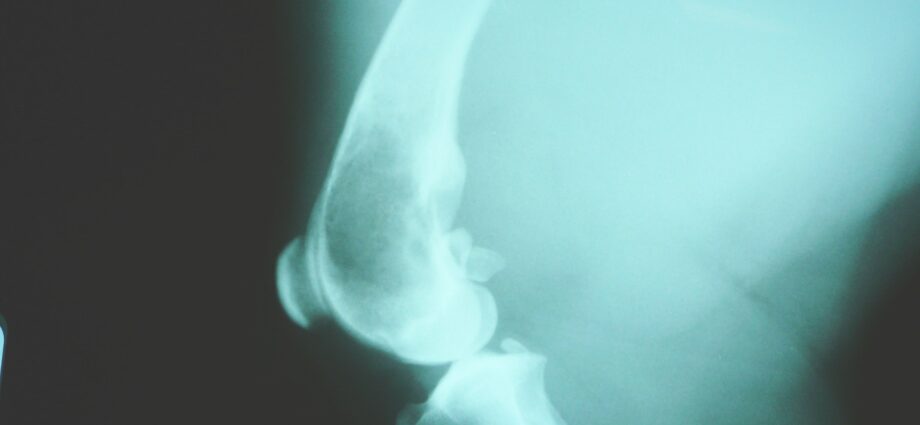Contents
Ostéosarcome
Osteosarcoma is one of the most common primary bone cancers. It most commonly affects children, adolescents and young adults. Particularly aggressive, osteosarcoma requires chemotherapy and surgery.
What is osteosarcoma?
Definition of osteosarcoma
Osteosarcoma is cancer of the bone tissue. It is known to be particularly aggressive, with in particular a risk of metastases. These are secondary cancers: the cells of the primary tumor migrate to other parts of the body. When osteosarcoma is diagnosed, metastases are seen in 10-20% of cases.
Osteosarcomas can develop in different parts of the skeleton. However, it is more common to see them at the ends of the bones near the joints. Osteosarcomas most often appear in the knee at the lower end of the femur or upper end of the tibia. They have also been observed in the hips, shoulders, pelvis, vertebrae, skull and jaw.
Classification of osteosarcomas
Cancers can be classified according to many parameters, and in particular according to their extent. We speak of staging in medical parlance. The extent of bone cancer is assessed in four stages. The higher the stage, the more cancer has spread throughout the body. Stages 1 to 3 correspond to localized forms. Stage 4 designates metastatic forms: cancer cells have migrated to other tissues in the body.
Note: bone cancer staging is not applied to tumors in the spine and pelvis.
Causes of osteosarcoma
Like many other types of cancer, osteosarcomas have an origin that is not yet fully understood.
To date, it has been observed that the development of osteosarcoma could be due or favored by:
- bilateral retinoblastoma, a type of eye cancer;
- Paget’s disease, a benign bone disease;
- Li-Fraumeni syndrome, a rare condition predisposing to different types of tumors.
Diagnosis of osteosarcoma
This type of cancer can be suspected in the cases mentioned above, or in the face of certain clinical signs. The diagnosis of osteosarcoma can be confirmed and deepened by:
- medical imaging tests such as x-rays, CT scans, magnetic resonance imaging (MRI) and bone scintigraphy;
- a biopsy which consists of taking a piece of tissue for analysis, especially if cancer is suspected.
These tests can be used to confirm the diagnosis of osteosarcoma, to measure its extent and to check for the presence or absence of metastases.
People affected by osteosarcoma
Osteosarcoma is one of the most common primary bone cancers. It remains a rare disease that affects an average of 3 cases per million each year.
In France, 100 to 150 cases are identified each year. The vast majority are adolescents and young adults.
Osteosarcomas are most often seen between the ages of 10 and 25, and mainly in boys. This type of bone cancer can nevertheless occur at other ages, especially in people between the ages of 60 and 70.
Symptoms of osteosarcoma
Bone pain
Bone pain is usually the first sign of bone cancer. The pain can be permanent or transient, more or less intense, localized or diffuse.
Local swelling
The development of osteosarcoma can lead to the appearance of a lump or palpable mass in the affected tissue.
Pathological fracture
The bone is weakened in the event of osteosarcoma. In a few cases, pathological fractures can occur spontaneously or following a slight trauma.
Treatments for osteosarcoma
Initial chemotherapy
This treatment is used to treat many types of cancer. It is based on chemicals capable of opposing the development of cancer cells. In the case of osteosarcoma, chemotherapy can reduce and limit the tumor foci before surgery.
Surgical intervention
After the initial chemotherapy, surgery is usually done to remove all of the tumor.
Post-operative chemotherapy
This second treatment with chemotherapy makes it possible to limit the risk of recurrence.
Immunotherapy
This is a new avenue of cancer treatment. It could be a complement or an alternative to the treatments mentioned above. Much research is underway. The goal of immunotherapy is to stimulate the body’s immune defenses to fight the development of cancer cells.
Prevent osteosarcoma
The origin of osteosarcomas is still poorly understood. Generally speaking, cancer prevention is currently based on maintaining a healthy lifestyle.
It is also recommended to seek medical advice in the slightest doubt. Early diagnosis promotes successful treatment and limits the risk of complications.










